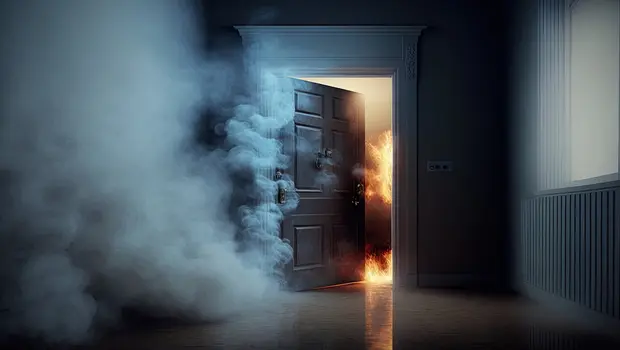
Posted on July 8, 2025
Fire-resistant doors are made from metal, fiberglass, or specially treated wood, which have a higher resistance to heat and fire.
Regarding safety in residential and commercial buildings, every component matters – down to the doors. In recent years, the choice between fire retardant and standard doors has become increasingly critical for architects, builders, and homeowners. The contrasting benefits of these doors can significantly impact your property's safety and longevity.
Fire-resistant doors, often called fire-rated doors, are made to slow down a fire. Depending on the door, they can do this for around 20 minutes to 3 hours. They're made from metal, fiberglass, or wood treated with special chemicals to resist fire.
Material Composition: Fire-resistant doors are made from metal, fiberglass, or specially treated wood, which have a higher resistance to heat and fire. These materials don't catch fire easily and provide a robust barrier against fire spread. Insulating Properties: These doors are designed to slow heat transmission from one side to the other. They protect the non-fire side, preventing it from getting hot and igniting. Fire Rating: Fire-resistant doors are tested and rated based on how long they can withstand a standardized fire resistance test. The ratings indicate how long a door can keep a fire from spreading. Intumescent Seals: These doors often feature intumescent seals, which expand in the event of a fire, sealing off the gaps around the door and preventing smoke and fire from spreading.
Standard doors, on the other hand, are for privacy and security. They're usually made of solid wood, metal, or a mix of materials but aren't made to slow down a fire.
The main difference between these two door types is their fire-resistance properties. A fire retardant door is designed to withstand high temperatures and slow the spread of fire, potentially saving lives and reducing property damage. However, functional and often stylish, standard doors will succumb to fire much more rapidly. The manufacturing process is also notably different. Fire retardant doors undergo a rigorous treatment process, where materials are imbued with fire-resistant chemicals or layered with fire-resistant cores. In contrast, standard doors are made without these safety measures.
They're safer: They can give people extra time to leave a building during a fire.
They lower damage: By slowing a fire, they can prevent more damage, saving you money.
They meet rules: Many building rules, especially for commercial or multi-family residential buildings, need fire-resistant doors.
They cost less: They're often cheaper without the extra fire-resistant steps, which is suitable for budget shoppers.
More styles: With less to worry about in the making, standard doors come in a broader range of looks for those interested in design.
Easy to install: standard doors usually need a less unique setup than fire-resistant doors, so they're quicker and cheaper to install.
Questions to Ask When Choosing a Door By asking these questions, you can ensure that you choose the right door for your specific situation, balancing safety, cost, aesthetics, and practicality.
Consider the building's fire safety requirements. Is it a commercial building, a multi- family residential building, or a single-family house? Regulations might differ.
Due to their complex manufacturing process and materials, fire-resistant doors cost more than standard doors. Can your budget accommodate this cost?
Although safety is paramount, aesthetic appeal also matters. Does the fire-resistant door come in a design that matches your decor?
Fire-resistant doors require a more specialized installation process. Are you prepared for this, or would you prefer the easier installation of a standard doorway?
Fire-resistant doors might require regular inspections to ensure their fire-resistant properties remain effective. Are you willing to commit to this maintenance schedule?
The right door depends on what you need. A fire-resistant door is a smart pick if safety and fire resistance are top priorities, especially in a commercial building or multi-occupancy home. A standard door might be better if cost and looks are more important.
At SplicePly, we have a range of fire-resistant and standard doors to suit different needs, looks, and budgets. Our experts are ready to help you choose your project best.
 How to Choose the Right Sunmica (Laminate) for Every Type of Furniture
How to Choose the Right Sunmica (Laminate) for Every Type of Furniture Top 5 Bedroom Interior Trends with Plywood in 2025
Top 5 Bedroom Interior Trends with Plywood in 2025.png) Different Types of Laminates & Their Applications: What’s Best for Your Home Interiors
Different Types of Laminates & Their Applications: What’s Best for Your Home Interiors.png) Diwali Decoration Ideas for Your Living Room - Splice Ply
Diwali Decoration Ideas for Your Living Room - Splice Ply 5 Reasons Why Splice Ply Plywood is Perfect for Modular Wardrobes
5 Reasons Why Splice Ply Plywood is Perfect for Modular Wardrobes.png) Premium Laminates for Wardrobes: Style Meets Durability
Premium Laminates for Wardrobes: Style Meets Durability.png) 5 Decorative Laminate Ideas for Kids Rooms
5 Decorative Laminate Ideas for Kids Rooms.png) Bedroom Interior Design: How to Choose the Right Plywood & Laminates for Long-Lasting Style
Bedroom Interior Design: How to Choose the Right Plywood & Laminates for Long-Lasting Style.jpg) Struggling with Bedroom space? Fitted wardrobes are here!
Struggling with Bedroom space? Fitted wardrobes are here!.jpg) Smart Furniture Ideas from Splice Ply for Your In-house Garden
Smart Furniture Ideas from Splice Ply for Your In-house Garden